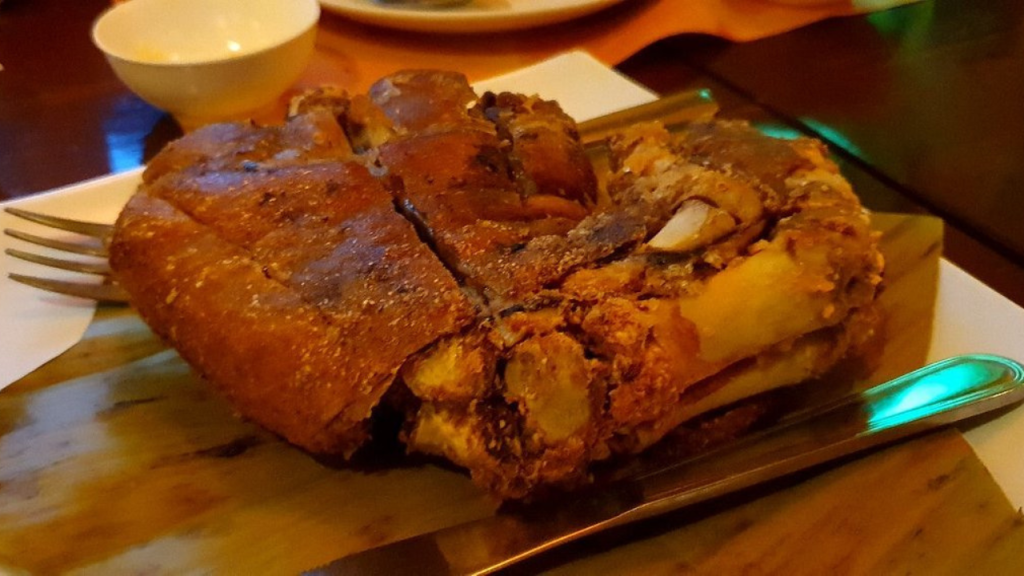
Cebu City, Philippines, is renowned for its rich history and vibrant culture. For many tourists, visiting Cebu has been an opportunity to wade into the beautiful coastlines of Mactan Island or Bantayan Island.
However, Cebuano cuisine also deserves praise. Complementing its storied past and the exciting Cebu City lifestyle, Cebuano food is an adventure of its own. Cebu food is a trove of diverse and flavorful dishes.
If you want to experience the Cebu City culture beyond Sinulog and its gorgeous beaches, you need to do a Cebu food trip. The next time you visit Cebu City, make sure to try some of the best Cebu delicacies.
Cebu Food Guide: Local Favorites, Hidden Culinary Treasures, and Famous Foods in Cebu
We’ve made a list of Cebu food and delicacies you need to try for your Cebu food trip: Here are seven of the most popular Cebu food:
1. Cebu Lechon (Lechon de Cebu)

Cebu City is regarded as the Lechon capital of the Philippines and arguably makes the best Lechon in the country. Some Cebuano restaurants like Rico’s Lechon have even expanded beyond Cebu City, bringing their lechon to a bigger audience in Metro Manila.
Lechon was introduced into Filipino cuisine by the Spanish. In fact, lechon is a Spanish word that means roasted suckling pig.
Since its introduction, it has evolved into a distinct traditional Filipino dish that’s more than just a roasted suckling pig.
Lechon Cebu is known for its crispy skin and juicy, flavorful meat. The pig is stuffed with local spices and herbs, including lemongrass, garlic, and green onions, and roasted over charcoal for hours.
Dubbed the “best pig ever” by chef Anthony Bourdain, Lechon de Cebu is famous worldwide. While other places in the country also specialize in lechon (whole roasted pig), many food enthusiasts can agree that Cebu lechon is in a league of its own.
The secret of the country’s best lechon lies in the unique seasoning and cooking technique, resulting in an irresistible blend of textures and savory flavor.
Elevate the experience:
Enjoy Cebu lechon with a signature dipping sauce. It combines vinegar and soy sauce with chili peppers, chopped onions, and tomatoes.
Where to Eat:
- Rico’s Lechon
- Zubuchon
- CnT Lechon
2. Sutukil

Sutukil is a combination of three cooking methods: “sugba” (grill), “tuwa” (stew or soup), and “kilaw” (raw seafood marinated in vinegar).
Sutukil, then, features fresh ingredients prepared in 3 different ways. Sutukil typically uses Cebu City’s freshest seafood, like fish, squid, or shrimp.
Sutukil is more a way of eating than a single dish. You can expect a full culinary journey when you sit down for a sutukil meal. Seafood is grilled to perfection, with a crunchy texture outside and tender meat within.
Cebuano cuisine also has its own spin on the tinola. Cebuano tinuwa has a flavorful broth derived from seafood (particularly clams) with green papaya, bringing a slightly sweet flavor yet fresh. It’s served hot and is a sure treat for the taste buds. Kinilaw is a Filipino version of ceviche.
It’s also one of the traditional dishes of Cebu City. Kinilaw has seafood prepared in vinegar and coconut milk marinade, flavored with aromatic spices. It has a distinct tangy flavor, and since it’s served fresh, it allows the seafood flavors to shine through.
Cebu’s coastal location makes fresh seafood plentiful, and Sutukil offers three distinct ways to enjoy it in one hearty meal, showcasing the versatility of local ingredients.
Where to eat:
- Sutukil restaurants on Mactan Island
3. Puso (Hanging Rice)

Puso is glutinous rice cooked and wrapped in woven coconut leaves, resembling a diamond shape (some argue that it looks like the human heart as its name suggests). It’s commonly eaten with Cebu delicacies like grilled meats or lechon.
This portable, eco-friendly way of serving rice makes it easy to eat while on the go or at gatherings. Its unique preparation and presentation have become one of the central Cebu delicacies.
Tip: Another rice variation popular in Cebu City is mais. It’s ground corn refined to become rice. It has smaller grains and a grittier texture, enhancing your culinary adventure.
4. Ginabot

Ginabot is Cebu’s version of chicharon bulaklak, consisting of deep-fried pork intestines. It has a crunchy exterior and a soft and juicy inside. It is often served with vinegar and soy sauce. And—you guessed it! This delightful treat is best enjoyed with puso.
Known as a “pungko-pungko” specialty (Cebuano street food eateries where diners squat on low benches), deep-fried ginabot is a popular street food for locals and tourists alike.
Its unique texture and flavor make it a savory treat for adventurous eaters.
Where to Eat:
- Ginabot sa Pardo
- CDU Pungko-Pungko (Mandaue City)
5. Bam-i

Cebu City has a very strong Chinese community, and a lot of Cebu delicacies and dishes have Fil-Chi roots, like steamed pork dumplings and ngohiong. Notably, one of these Cebu delicacies is bam-i.
Bam-i is a noodle dish made from a mix of stir-fried noodles, bihon (thin rice noodles), and canton (egg noodles), stir-fried with meat, seafood, and local vegetables.
This Cebu food staple is a mainstay in celebrations and gatherings in Cebu City due to its hearty and flavorful nature. Bam-i is often cooked with a variety of ingredients, making each bite rich and satisfying.
Where to Eat:
- Mabolo Bam-i House
- Lantaw Floating Restaurant
6. Tuslob Buwa

Tuslob buwa deserves a spot in your Cebu food trip, especially if you’re looking for an offbeat option.
Tuslob buwa (translates to ‘dip in bubbles’) is made primarily of pork liver, pig’s brain, and pork broth. It’s one of the more unique Cebuano delicacies, hailing from Pasil, Cebu City.
In this dish, the pork offcuts are deep-fried in their own oils and served in a heated pot. The pork offcuts are heated and eventually become some type of dipping sauce where you dip (tuslob) hanging rice.
The flavor can be likened to pork pate, so it’s a Cebuano street food dish for those with daring taste buds.
7. Chorizo de Cebu

Cebu City puts its own spin on the chorizo. Chorizo de Cebu is a pork sausage with salt, garlic, and local spices.
They have a distinctly red color because of the achuete seeds, a main ingredient of this Cebuano food item. They are known for being garlicky and have a slightly sweet flavor.
You can enjoy this Cebuano delicacy deep-fried or even grilled!
Sweet Desserts to try:
No Cebu food trip is complete without sweet Cebu delicacies. Whether you’re looking for desserts to end your meal or to snack on, here are some treats to satisfy your sweet tooth:
Rosquillos

Rosquillos are ring-shaped cookies made primarily from flour, eggs, sugar, baking powder, and shortening. The cookie originates from Cebu City, specifically Lilo-an.
The creation of rosquillos is attributed to Titay’s, which is now a popular store for Cebu delicacies and pasalubong.
Masareal

Masareal is one of the more underrated native delicacies from Cebu. It’s made from finely ground peanuts, sugar, and water. It’s typically molded into rectangular bars wrapped in white paper.
The dessert originated in Mandaue City, near Cebu City, and has a subtle sweetness with a nutty flavor, making it a simple yet beloved treat.
Budbud Kabog
Budbud Kabog is a unique Cebuano food made from millet seeds (kabog), coconut milk, and sugar, wrapped in banana leaves. This dessert has a distinct, slightly nutty flavor, and a texture that’s both sticky and chewy.
It’s traditionally steamed and served with a side of coconut palm sugar/muscovado sugar, enjoyed with a hot chocolate drink or coffee.
Runner-up Cebu Delicacies:

There are endless great dishes in Cebu City, and here are some worth mentioning that didn’t quite make our list:
- Crispy pata
- Ngohiong (a deep-fried spring roll with ground pork or shrimp, local herbs and spices, and jicama or heart of palm)
- Pinaypay na saging (frittered saba bananas)
Make the Culinary Haven Cebu City Your Home

With all the mouthwatering Cebuano delicacies, living in the Queen City of the South is a worthy investment. On top of being a gastronomic hub, Cebu City is also a great city to live in.
In recent years, Metro Cebu has had a wealth of developments, from world-class infrastructure to an incredibly progressive economy.
With Camella, you can be at the heart of Cebu City. Camella neighborhoods are strategically placed throughout the Cebu City area.
If you’re looking for a more laid-back community right outside of the city, Camella also has a range of developments in places like Carcar and Bogo. Camella offers you a diverse range of properties in Cebu City and its surrounding areas to fit your lifestyle.
Camella in Carcar

Carcar City has a tight knit community, preserving traditional Cebuano cultures. A home in Camella Carcar situates homeowners in the middle of this vibrant community, close to transportation lines and major centers.
The 40-hectare Camella Carcar offers homes of contemporary beauty with its Spanish-inspired architecture.
It is conveniently connected to the main city center through Cebu South Road, captivating prospective investors with its blend of the exciting city rush and longed-for respite.
Camella in Bogo
One of the frontrunners outside of Metro Cebu has to be Bogo City due to the rapid developments in the area. The 17-hectare Camella Bogo community combines the best present-day and rustic living, with Spanish-Mediterranean homes ideal for first-time buyers or those looking to establish long-term roots.
No matter where you are in Cebu, Camella ensures that you’re set up for the future in Cebu City. Camella in Cebu City provides top-notch amenities and impeccably designed homes.
More importantly, Camella’s master-planned communities in Cebu City allow you to take part in the Cebuano way of living, including its food and culture.

Celebrate Life’s Milestones in Camella!
Make unforgettable memories in a Camella home.
Our communities are designed to elevate your living experience.


